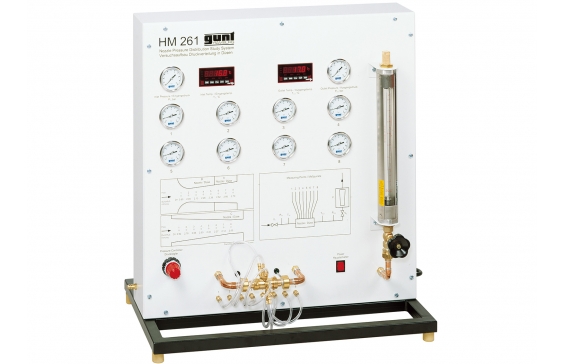HM 261 Nozzle pressure distribution

Convergent nozzles are used in the subsonic range. Velocities in the supersonic range can be achieved in de Laval nozzles; their nozzle geometry is a combination of convergent and divergent contours. De Laval nozzles are used in supersonic wind tunnels, steam turbines, jet engines and rocket technology. Pressure curves are a good way of representing the different velocity ranges in the nozzle, such as subsonic, supersonic and shock wave.
The experimental unit HM 261 is used to measure pressure curves in convergent and convergent-divergent nozzles (de Laval nozzles) and to study the actual flow of compressible fluids. In addition, the “choking effect” is demonstrated, where the mass flow rate stops increasing upon reaching the critical pressure ratio. Air is used as a compressible fluid.
In the experiment, the air flows through a nozzle and is thus accelerated. The pressure curve is recorded in the direction of flow over several measuring points. The air pressure upstream and downstream of the nozzle can be adjusted.
Three interchangeable nozzles are available to study the pressure and velocity ratios: one convergent contour and two de Laval nozzles with different length nozzle extensions.
The measured values for temperatures, pressures and mass flow rate are recorded.
- pressure distribution in convergent and divergent nozzles
- three nozzles with different contours
- velocity of sound and shock wave
Air consumption of the experimental unit
- compressed air: max. 10bar
- air consumption: approx. 5g/s
3 nozzles, brass
- 1 x de Laval nozzle, short nozzle extension
- 1 x de Laval nozzle, long nozzle extension
- 1 x convergent nozzle
Compressed air regulator
- control range: 0…8,6bar
Measuring ranges
- temperature: 0…100°C
- pressure: 2x 0…10bar, 8x 1…9bar
- mass flow rate: 0,7…8,3g/s
230V, 50Hz, 1 phase
230V, 60Hz, 1 phase; 120V, 60Hz, 1 phase
UL/CSA optional
- nozzle pressure distribution in actual flow of compressible fluids
- three nozzles with pressure measurement points: 1 convergent nozzle, 1 short and 1 long de Laval nozzle
- compressed air regulator for adjusting the pressure downstream of the nozzle
- needle valve on the flow meter for adjusting the back pressure
- instruments: manometer and digital temperature display upstream and downstream of the nozzle as well as rotameter
- pressure curve in
- de Laval nozzles
- convergent nozzles
- connection between inlet pressure and mass flow rate or exit pressure and mass flow rate
- how pressure drop in the nozzle affects the temperature
- determining the critical pressure ratio (Laval pressure ratio)
- demonstration of the “choking effect”
- proof of shock waves
